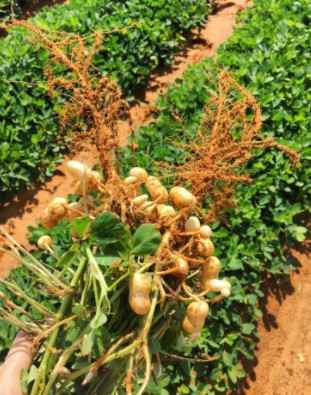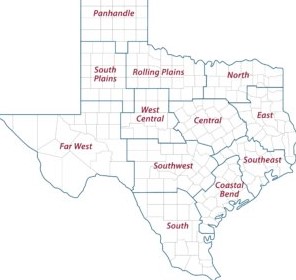By Adam Russell
Texas peanut harvest is underway, and producers are expecting lower per-acre yields than last season, according to a Texas A&M AgriLife Extension Service expert.
Emi Kimura, Ph.D., AgriLife Extension agronomist and state peanut specialist, Vernon, said peanut acres were up, but that she expected yields to be down due to drought conditions.
Crop surveys by the U.S. Department of Agriculture show Texas producers planted 165,000 acres in 2019 and estimate that 190,000 acres were planted in 2020, up 25,000 acres.
Texas producers dig several different peanut types including Spanish, Valencia and Virginia varieties, she said. Most Texas acres are planted as runners, the most widely consumed type.

Peanut harvest should ramp up over the next few weeks and wrap up toward the end of October.
A few producers might have started digging their fields, Kimura said, and some will begin next week in the Rolling Plains and West Texas. Digging will ramp up over the next few weeks, and producers will be busy through mid-October.
The season began with planting in the northern Rolling Plains and West Texas in the first week of May and in West Texas and a little later for Central and South Texas, she said.
Cold snaps in April slowed germination in the Rolling Plains, but followed with plenty of heat units, Kimura said. But there was not enough rain to keep up with plants’ water demands despite irrigation.
Peanuts in Central, South and especially West Texas faced worse conditions early, but rains helped Central and South Texas fields. West Texas was worst off due to drought.
“It was so dry in West Texas in July and August that irrigation couldn’t keep up with plants’ demand,” Kimura said. “Conditions in Central and South Texas and the Rolling Plains were not as dry as the west, and the overall effects of drought are difficult to estimate at this point.”
Kimura said temperatures were cooler than normal during September, which also likely slowed the crop’s progress some, and that frost in the windrows before late October could be trouble.
Peanut yields down
Last year, the average yield in Texas was 3,100 pounds per acre. The September forecast estimated yields to be 2,900 pounds per acre.
Kimura said drought was the factor that contributed to the yield reduction most because there was below average pest and disease pressure this year.
There were reports of crown rot and leaf spot, but damages were not significant, likely due to proactive spraying. There were also reports of pod rot, but the extent of damage won’t be known until peanuts are harvested.
Kimura said peanut producers will need to time their harvest well to maximize pound-per-acre yields. Producers are advised to check peanut maturity by digging samples in several locations around their field to determine when to harvest.
“They need to target the right timing to have the pods intact and attached to the vine and minimize immature pods,” she said. “It’s one of the hardest decisions to make as a producer.”
AgriLife Extension district reporters compiled the following summaries:

A map of the 12 Texas A&M AgriLife Extension districts.
CENTRAL
Conditions were good, and temperatures were cooler. Rainfall amounts were 1-3 inches. Some producers were spraying for fall armyworms. Pastures rebounded very well with rainfall, and livestock looked good. Producers were planting winter grazing crops and cutting hay, but rainfall caused some delays. Soil moisture levels were generally adequate with a good recharge of subsoil moisture levels. Fieldwork continued to clean up the heavy volunteer crop and weed growth. All corn, sorghum and cotton were harvested. One more cutting of hay was expected in October.
ROLLING PLAINS
The district reported cooler temperatures. Cotton fields were fair to good condition and some had reached boll opening. Wheat producers continued planting. Pasture and rangelands were in fair to good condition and continued to improve.
COASTAL BEND
Tropical Storm Beta brought rain to much of the reporting area. Wharton County reported 5-7 inches of rainfall. Most farming operations were put on hold due to wet conditions. The remaining 1,000 acres of soybeans that were defoliated prior to tropical storm have developed some mold and shattering. There was still a very small amount of cotton acres yet to be harvested, and acres needed stalk destruction. The ratoon rice crop was still in a reproductive stage. Winter pastures were being planted. Rangelands and pastures were improving daily. Ponds were still low in most areas and continued to be a concern for producers. Livestock were in good condition, with supplemental feeding slowing drastically.
EAST
Rain from the recent tropical storm swept through the district. Some areas received as much as 7 inches. Sabine County reported bottomlands were too wet for hay harvesting, but many upland areas were well drained and being cut. Panola County reported producers were looking forward to a late October hay cutting for an already above-average production season. Many other areas reported warm-season grass growth was slowed due to cooler temperatures. Pasture and rangeland conditions were good. Subsoil and topsoil conditions were adequate. Livestock were in good condition. Fly numbers were still high. Producers were monitoring for armyworms. Feral hogs were active and caused a lot of damage.
SOUTH PLAINS
Subsoil and topsoil moisture levels remained poor due to the lack of moisture and moderate temperatures. Crops were in the last stretch of growth. Producers continued to monitor watering conditions. Cattle were in good condition.
PANHANDLE
Weather conditions were mild. Northern parts of the Panhandle reported adequate subsoil and topsoil moisture. Central areas reported short subsoil and topsoil moisture, and southern areas reported very short subsoil and topsoil moisture. Pasture and rangeland conditions were very poor to good. Corn was mature, and harvest was underway. Cotton was in poor to good condition. Sorghum condition was poor to fair.
NORTH
Soil moisture was mostly adequate across the district. Cooler weather continued with some light precipitation totaling 0.5-3 inches, which maintained adequate soil moisture levels. Producers were taking advantage of the good weather to get another cutting of hay and prepare for planting winter pastures. Bermuda grass growth started to slow due to cooler temperatures. Wet weather delayed cotton and soybean harvests and wheat planting. Feral hogs were active.
FAR WEST
Temperatures were above 100 degrees with nighttime lows in the low 50s. No rainfall was reported. Cotton harvest was about to begin. Quite a few fields were defoliated already with many more ready to be sprayed as soon as the weather cooperates. Cotton yields were not expected to be great. A little more wheat was planted, but the majority was expected to be planted after cotton harvest. Alfalfa farmers were making the last cutting, but some may get a clipping in October. Pecans were finishing up, but yields were not expected to be great. Pastures were still very dry with no forages, and producers continued to feed livestock.
WEST CENTRAL
Conditions were warm and dry, which allowed for excellent growth in wheat and oat fields. Armyworms and grasshoppers continued to emerge, and producers were actively scouting and spraying fields as needed. An abundance of cool-season annual weeds and forages emerged due to the abundant soil moisture levels. Stock tanks were full and in good shape. Pastures greened up. Livestock were in mostly good condition due to the rapid growth occurring over the last month.
SOUTHEAST
There were heavy rains with some flooding and standing water in some areas. Fall armyworms were reported in Brazos County. Rangeland and pasture ratings varied from excellent to poor with fair ratings being the most common. Soil moisture levels ranged from adequate to surplus with adequate levels being the most common.
SOUTHWEST
Some areas received up to a quarter inch of rain while others remained dry. Rangeland and pasture conditions were looking good. The last hay cuttings were underway. Small grain planting was wrapping up, and cool-season vegetation was greening up. There were reports of armyworms. Livestock were in fair to good condition. Livestock markets were steady. Sheep producers were currently lambing while weather conditions were favorable.
SOUTH
No rainfall was reported, but weather was mild to cool with short to surplus soil moisture levels. Temperatures cooled in most areas. Jim Hogg reported temperature highs in the 80s and 90s and a low of 53 degrees. Producers were busy on a range of fieldwork where soil moisture levels would allow. Cotton harvest continued and was almost complete in some areas. Peanut harvest should begin soon. Most strawberry producers will start planting soon. Forage producers were working between rain showers. Wheat and cool-season forage plantings started. Bermuda grass and Sudan hay fields and silage sorghum were being cut and baled. Pasture and rangeland conditions continued to improve in areas that received recent rainfall. Good grazing reduced supplemental feeding in some areas. Heavy morning dew helped maintain soil moisture levels. Stock tanks were mostly full. Most watermelon and cantaloupe harvesting were complete, and farmers were preparing for next season. Pecan orchards were in good condition and were expected to be harvested soon. Preparations for fall vegetable plantings continued. Most harvested spring croplands were cleared of plant debris.
Source : tamu.edu